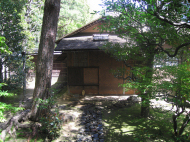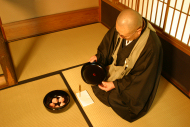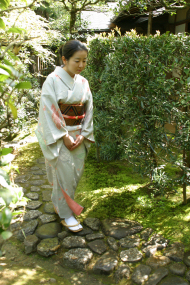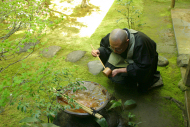In this Room

(1) The Sa-an at Gyokurin-in in Kyoto.
Japanese teahouses functioned as a place where like-minded individuals could escape the ordinary world and enjoy a few moments of tranquility, precious art objects, and a refreshing bowl of tea. Even though a small teahouse might be built only a short distance from a house or temple, the owner would create a dense garden to make it seem like it was located deep within the wilderness.

(2) A state of calm permeates the cha-no-yu.
Typically, tea masters designed teahouses to look rustic, like old, abandoned huts.(1) The walls might be fashioned from mud and straw. Carpenters would use unmilled posts and beams, as well as water reeds and bamboo so that it looked like the house was built from natural materials gathered from the surrounding forests.
Within the teahouse, all unnecessary embellishment is eliminated in an attempt to create a state of calm.(2) It is here, in such a modest structure, that a tea master prepares and serves tea to a small number of guests. This is a traditional ritual known as cha-no-yu, or the tea ceremony.
Tea Ceremony
Japanese architecture, garden design, painting, calligraphy, ceramics, lacquerware, flower arranging, and even food preparation have all been influenced by the tea ceremony. For such a ceremony, a tea master carefully orchestrates every detail, selecting the appropriate wares and decorations that will reflect the tastes of the guests, the season, and even the time of day. Thus, each tea ceremony becomes a unique and complex experience. Yet at its core, the ceremony remains as a simple act of sharing a bowl of tea in a calm and contemplative atmosphere.

(3) The entrance emphasizes humility.
In a tea ceremony, guests make their way to the teahouse along a garden path devoid of showy flowers. The small entryway into the teahouse requires guests to express their humility by bowing low to enter into the space.(3) The tea master will have chosen a work of art—usually a hanging scroll—for his guest's enjoyment. And, after sliding into the teahouse, the guest reverently examines this prized object before taking their position.
The sound of boiling water in the iron kettle and the pouring of water into the tea bowls provides a subtle music to the proceedings, since the tea ceremony is conducted in virtual silence. The bitter taste of the tea is balanced by the subtle flavor of traditional sweets served beforehand. Finally, guests have the rare chance to examine treasures from the tea master's collection in the form of antique tea bowls, ceramic and lacquered tea caddies, and carved tea scoops that he has specially chosen for the gathering.
The Tea Garden

(4) The garden path to the Sa-an.
The Tea Garden provides a vital transition between the mundane world and the sanctified atmosphere of a teahouse. Known as a roji, or "dewy path," a tea garden should resemble a timeworn trail through a deep forest, even though it can traverse only a short distance and be located in a busy urban area.(4) Garden designers use each element in the garden to help visitors achieve a state of mental and spiritual tranquility. Trees obscure the outside world and thus draw the visitor's attention inward. The irregularly arranged stones of the pathway cause guests to slow their pace and quiet their minds.
A series of gates also can help give the impression that one is traveling far into another realm. Showy flowers and decorative objects are avoided, making the overall impression one of great naturalness and age, an effect enhanced by an array of mosses and leafy ground covers.

(5) Participants symbolically purify themselves before entering the teahouse.
Before entering the teahouse, guests stop at a special grouping of stones around a tsukubai, a stone basin, filled with fresh water. Using a new cedar ladle provided by the host, they rinse their hands and mouths, an act of symbolic purification similar to that performed at sacred Shinto shrines.(5) A simple stone lantern nearby provides light for tea gatherings held in the very early morning or at night.
Teabowls
The teabowl, or
chawan ("CHAH-wahn"), is the most important object of the tea ceremony. It is handled with utmost reverence and raised to the lips using both hands. After drinking, a guest is expected to examine the bowl and comment on its beauty before returning it to the host. Teabowls vary widely in form and color. Deeper, thick-walled bowls are used in winter, while thinly potted, shallow bowls are preferred during summer. Because teabowls are meant to be held firmly, their tactile quality is as important as their visual appeal.
Slightly irregular shapes, which feel comfortable in the hands and against the lips, are prized, as are appealing textures from the natural clay or thick, unctuous glazes. While teabowls imported from China and Korea were greatly prized by early tea masters, the demand for greater variety encouraged the production of teabowls in Japan and many unique styles eventually emerged.
Tea Caddies
Although there are many variations, the tea ceremony can be divided into two types. For formal tea gatherings, guests are served a light meal (
kaiseki, "KAH-ee-seh-kee") followed by
koi-cha ("KOH-ee-chah"), or thick tea. In less formal gatherings, guests are served small cakes or other sweets followed by a bowl of
usu-cha ("OO-soo-chah"), or thin tea.
Powdered tea for koi-cha is made from older tea leaves and has a pungent taste. Because three scoops of tea are used for each bowl, koi-cha has a rather thick consistency. Tender, young leaves are harvested, dried and ground for usu-cha, which has a light, fresh taste. Only two scoops of tea per bowl are used for usu-cha, enabling the tea master to whip the tea and water to a frothy foam with a bamboo whisk.
Koi-cha is stored in small, ceramic containers fitted with ivory lids. Such containers, called cha-ire ("CHAH-ee-day"), were originally imported from China where they were used to store medicines. Appreciation of cha-ire depends on the potter's skill and precision in forming the mouth, shoulder and foot of these small vessels. Small bags fashioned from fragments of antique brocade are used to display the cha-ire prior to use in the tea ceremony.
Tea for usu-cha is stored in small lacquer containers called natsume ("NAH-tsoo-may"). Like cha-ire, natsume are made in a variety shapes. Although plain black natsume have remained popular since the sixteenth century, they are often ornamented with delicate designs of sprinkled gold and inlaid mother-of-pearl.
Mizuya (Preparation Area)
Mizuya ("MEE-dzoo-yah") literally means "water room," suggesting its function as a preparation area where the tea master can wash tea utensils and otherwise prepare for the tea ritual in the adjoining room. Although rarely seen by the guests, the mizuya is elegantly designed and fastidiously maintained. Here, the tea master would arrange only the wares he intended to use so that he would be able to retrieve them as necessary during the ceremony without disrupting the tranquil atmosphere he has worked so hard to create.